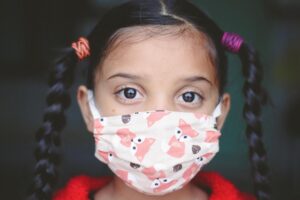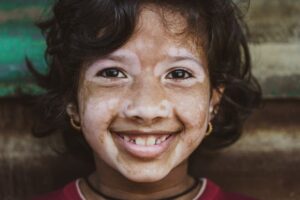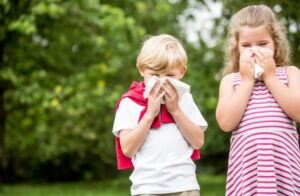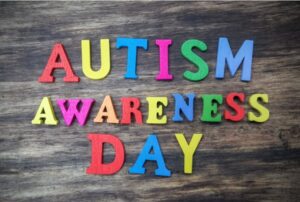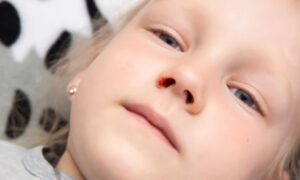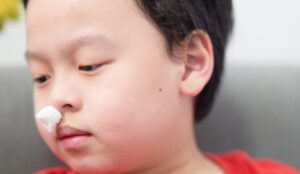What is Pityriasis Alba?
Pityriasis alba is a common skin condition in children, typically presenting as lightly depigmented patches with fine, flaky scales. These patches have indistinct borders and usually do not cause pain or itching. While the condition is mostly cosmetic, it can be concerning for parents. Pityriasis alba most commonly affects children between the ages of 3 and 16, particularly those with dry skin or darker skin tones.
The patches typically appear on the face, especially on the cheeks and around the mouth, but they can also occur on the neck, shoulders, and, in rare cases, on the trunk and limbs. This condition is generally harmless and often resolves on its own, though it is important for parents to understand its causes and preventive measures.
Causes of Pityriasis Alba
Pityriasis alba is influenced by several factors, and it is especially common in children. Here are some possible contributing factors:
1. Excessive Sun Exposure
Pityriasis alba is more prevalent in the spring and summer, especially among children who spend long hours outdoors in the sun. Ultraviolet (UV) radiation can cause uneven skin pigmentation, leading to the development of pityriasis alba patches.
2. Nutritional Imbalance
Children with picky eating habits or an imbalanced diet may be more prone to developing pityriasis alba. Ensuring that children receive a varied diet that includes plenty of fruits, vegetables, and whole grains is crucial for skin health.
3. Improper Skincare
Excessive cleansing or failure to moisturize the skin during dry seasons may trigger pityriasis alba. Keeping the skin hydrated, particularly during cold or dry months, is an important measure to prevent this condition.
4. Parasitic Infections
Although parasitic infections were once linked to pityriasis alba, this cause has become less common in modern urban environments. If pityriasis alba occurs, other factors should be considered first, and anti-parasitic medications should not be used without medical consultation.
Differences Between Pityriasis Alba and Vitiligo
Pityriasis alba and vitiligo may appear similar, but they are two distinct skin conditions. Vitiligo presents with well-defined white patches that are smooth and scaleless, and these patches generally do not cause itching or pain. In contrast, pityriasis alba has indistinct borders and is often accompanied by fine, flaky scales.
Parents should monitor the condition closely. If the patches do not show improvement after 2 to 3 months, or if the patches become whiter or spread, it is important to consult a dermatologist for a proper diagnosis.
How to Treat Pityriasis Alba?
In most cases, pityriasis alba does not require medical treatment and typically resolves on its own. However, parents can take the following steps to alleviate symptoms and promote skin healing:
1. Moisturize the Skin Regularly
Apply a moisturizing lotion or cream, especially to the affected areas, to keep the skin hydrated. Using products containing vitamin E can help restore normal skin function and reduce dryness.
2. Sun Protection
Excessive sun exposure can exacerbate pityriasis alba, so it is important to avoid outdoor activities during peak sunlight hours, typically between 10 a.m. and 4 p.m. Sunscreen should be applied, and protective clothing, such as hats, should be worn when outdoors.
3. Balanced Diet
Ensure that your child receives a balanced diet, including plenty of vitamins and minerals. Vitamins A, C, and E are particularly important for skin health. It is also essential to limit the intake of high-fat and high-sugar foods to maintain healthy skin.
4. Avoid Harsh Skincare Products
Avoid using harsh or scented cleansers on the skin. Opt for gentle, fragrance-free skincare products, and apply a moisturizer immediately after bathing to lock in moisture.
5. Use Vitamin E Cream if Recommended
With medical advice, you can use vitamin E cream to help improve the skin's condition. Vitamin E has been shown to help with skin repair and reduce pigmentation irregularities.
Prevention Tips for Pityriasis Alba
While pityriasis alba usually resolves on its own, taking preventive measures can help reduce the risk of recurrence:
- Regular Moisturization: Keep your child's skin well-moisturized, especially during dry months, to prevent dryness and flakiness.
- Sun Protection: Minimize sun exposure, especially during peak hours. Apply sunscreen and dress your child in sun-protective clothing when necessary.
- Healthy Diet: Ensure your child eats a balanced diet that includes plenty of fruits, vegetables, and whole grains to support overall skin health.
- Avoid Harsh Skincare Products: Choose gentle, fragrance-free products and avoid over-cleansing the skin to prevent irritation.
Final Thoughts
Pityriasis alba is a common skin condition in children that typically does not require medical treatment and usually resolves on its own. However, parents should take appropriate measures to manage symptoms and promote skin healing. Moisturizing regularly, avoiding excessive sun exposure, and ensuring a balanced diet can help prevent the condition. If symptoms persist or worsen, it is advisable to consult a dermatologist for further evaluation and treatment.
References:
- Mayo Clinic. "Pityriasis Alba."
- American Academy of Dermatology (AAD). "Pityriasis Alba."
- National Eczema Association (NEA). "What Is Pityriasis Alba?"
Frequently Asked Questions (FAQ)
Q1: How long does it take for pityriasis alba to fully resolve?
Pityriasis alba usually improves over a few months. Most children’s skin returns to normal within 2 to 3 months.
Q2: Is pityriasis alba hereditary?
Pityriasis alba is not hereditary, but children with a family history of eczema or other skin conditions may be more likely to develop it.
Q3: Is pityriasis alba contagious?
Pityriasis alba is not a contagious skin condition and cannot be spread to others through contact.
Q4: How should I apply vitamin E cream to my child’s skin?
It is best to consult a doctor before using vitamin E cream. Generally, vitamin E cream can help soothe dry skin and improve pigmentation, but it should be used in moderation.





